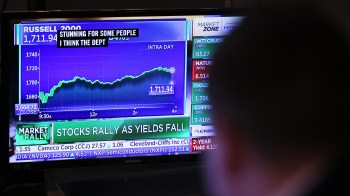Market volatility continues, but for how much longer?
Steve Chiotakis: And one more sour economic report out today. A drop in the number of people who bought pre-owned homes in July. The National Association of realtors said today home sales fell 3.5 percent last month. So with all of this data, and the markets today on a big tear, what is going on?
Kevin Flanagan is managing director and chief fixed income strategist for Morgan Stanley Smith Barney. And he’s with us now from suburban New York. Good morning, Kevin.
Kevin Flanagan: Good morning.
Chiotakis: Now, people are pointing to these ongoing concerns about Europe and the European debt crisis as the reason the markets are sort of on a tear going down. But these, as I said, are ongoing. Why such a plunge today?
Flanagan: I think the markets are on heightened alert for any signs of a continued slowdown in the economy — the double-dip recession concerns. And we got a couple of anecdotal reports. One of them is the Philadelphia Fed survey, not to get to technical on you. But it plunged, and that really precipitated what we’ve been seeing up to this point.
Chiotakis: And investors really pay attention to that stuff, right?
Flanagan: Yeah, they do, you know. And in an environment of heightened concerns and uncertainty unfortunately these things can be amplified.
Chiotakis: I want to talk to you about the weekly jobless numbers as well, because we crossed over that 400,000 who applied for unemployment last week. Discouraging numbers. Can we really take a weekly number and hang a lot of meaning on it?
Flanagan: No, you really shouldn’t. The monthly numbers obviously provide a lot better snapshot of what we’re looking at for labor force trends. But one thing to keep in mind even though we’re at, around, that 400,000 level — jobless claims are down roughly 80,00 from the peaks we saw in April. So we have seen some improvement.
Chiotakis: We’re seeing investors fleeing now. The “flight to safety” as it were to U.S. Treasury bonds. This is the same debt that was downgraded by Standard & Poor’s a few weeks back. What gives there?
Flanagan: Yeah, that’s interesting. Probably if we had led with the bond story you probably could have had more uplifting music to start. But you know, I think the flight to quality trade — investors sort of gave a resounding answer to the S&P downgrade. And in terms of money flows, U.S. treasuries are still considered AAA.
Chiotakis: All of this going on, Kevin — bad data, the volatitily, the European debt crisis — it’s hard not to think that we’re heading back to recession, yeah?
Flanagan: Well that would seemingly be where the markets are taking us to at this point in time. Our base case is that you will see some improvement actually in the second half of the year, although the word “improvement” is relative. So I think we can avoid the textbook definition of a recession. But the probabilities are certainly higher now than where they were just a few months ago.
Chiotakis: Bottom line, Kevin, do the “wild swings” continue?
Flanagan: Yeah, I think volatility is going to be a hallmark of financial trading for the next six to twelve months.
Chiotakis: Kevin Flanagan with Morgan Stanley Smith Barney. Kevin, thanks.
Flanagan: Thank you.
There’s a lot happening in the world. Through it all, Marketplace is here for you.
You rely on Marketplace to break down the world’s events and tell you how it affects you in a fact-based, approachable way. We rely on your financial support to keep making that possible.
Your donation today powers the independent journalism that you rely on. For just $5/month, you can help sustain Marketplace so we can keep reporting on the things that matter to you.


















